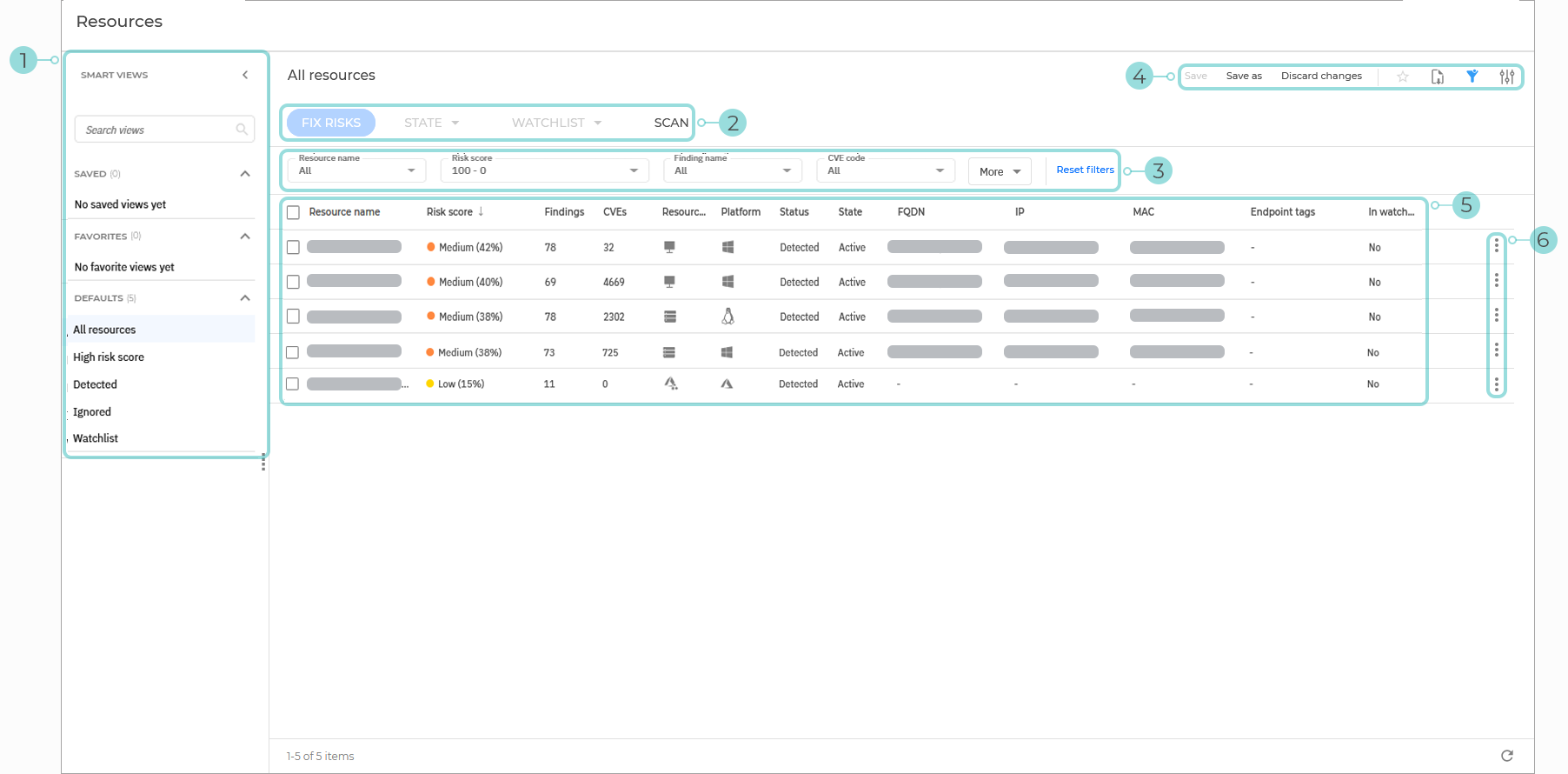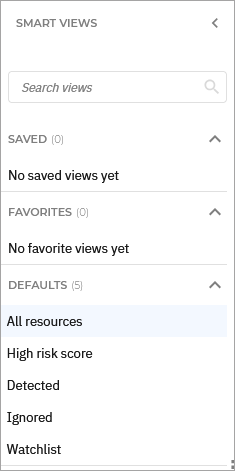Resources
The Resources page displays all the scanned workstations, servers and cloud assets under your management. It provides detailed info of their name, level of severity, resource type, and number of risks affecting them.

The Smart views panel toggle button. This feature allows you to customize, save, and switch between different loadouts of the Resources page.

The panel has the following sections:
Search views - Use this search field to filter out the views displayed in the sections below, by name.
Saved - This section displays a list of all your saved views that have not been marked as favorites.
Favorites - All views marked as favorites are displayed under this section.
Defaults - This section displays the views that are available by default:
All resources
High severity
Detected
Ignored
Watchlist
For any view in the Saved or Favorites category, you can click the vertical ellipses
to Rename or Delete the view.
The Resource actions. This section contains the buttons to all the available actions you can take on the resources displayed on the page:
Fix risks - Generate a task to attempt to automatically fix the risks on the selected resources.
State - Change the state of the selected resources. The following options are available:
Ignore resource
Restore ignored resources
Watchlist - Add or removed the selected resources from your watchlist. The following options are available:
Add to watchlist
Remove from watchlist
Scan - Perform a scan to check for new risks or updates on known risks.
The Filters section. You can use these options to customize the risks that are displayed in the below grid.
The following filters are currently available:
Filtering option
Details
Resource name
Use the searchable drop-down menu to filter the list of resources by name. Select the resources you want to display and click Apply.
Only the selected resources are displayed.
Risk score
Select a risk score range between 1 and 100.
Only resources with a risk score between these values are displayed.
Finding name
Use the searchable drop-down menu to filter the list resources by associated findings. Select the findings you want and click Apply.
Only the resources where the selected findings have been detected are displayed.
CVE code
Use the searchable drop-down menu to filter the list of resources based on the CVE codes assigned to their associated vulnerabilities. Select the CVEs you want to display and click Apply.
Only resources where the by the selected CVEs have been detected are displayed.
Resource type
Use the searchable drop-down menu to filter the list of resources by type. Select the types you want and click Apply.
Possible values:
Workstations
Servers
Cloud resources (multiple values)
Only resources of the selected type are displayed.
Platform
Use the searchable drop-down menu to filter the list of resources by operating system. Select the operating systems you want and click Apply. Possible values:
Unknown
IOS
Android
Windows
Linux
Solaris
Mac OS X
Container
Only resources that affect the selected operating systems are displayed.
Status
This filter allows you to filter the list of resources by their status.
Use the searchable drop-down menu to filter the list of resources by status. Select the states you want and click Apply. Possible values:
Compliant
Detected
Only resources with the states you selected are displayed.
State
This filter allows you to filter the list of resources by their state.
Use the searchable drop-down menu to filter the list of resources by state. Select the states you want and click Apply. Possible values:
Active
Ignored
Only resources with the states you selected are displayed.
FQDN
Use the searchable drop-down menu to filter the list of resources by FQDNs. Select the FQDNs you want and click Apply.
Only the resources that the FQDNs you selected belong to are displayed.
Mac
Use the searchable drop-down menu to filter the list of resources by Mac address. Select the addresses you want and click Apply.
Only the resources that the Mac addresses you selected belong to are displayed.
Endpoint tags
Use the searchable drop-down menu to filter the list of resources by applied tags. Select the tags you want and click Apply.
Only the resources that the tags you selected belong to are displayed.
In watchlist
Use this filter to display resources based on them currently being included in a watchlist or not. Possible values:
Yes
No
IP
Use the searchable drop-down menu to filter the list of resources by IP. Select the IPs you want and click Apply.
Only the resources that the IPs you selected belong to are displayed.
Region
Use the searchable drop-down menu to filter the list of resources by region. Select the region you want and click Apply.
Only the resources located in the regions you selected are displayed.
Resource ID
Use the searchable drop-down menu to filter the list of resources by ID. Select the IDs you want and click Apply.
Only the resources that the IDs you selected belong to are displayed.
The View options menu. This section provides you with multiple functions for working with views:
Save - Save changes you make to a saved view.
Save as - Save a modified view under a different name.
Discard changes - Revert the saved view to its original state.
Export view - Download the information in a
.csvfile, which can contain up to 1500 rows.Add to favorites - Add the view to the Favorites category.
Show or hide filters - Hide or display the filters menu.
Open settings - Display the Settings panel.
You can use this panel to customize what columns are displayed in the view and enable or disable the Compact view.
The Resources grid. The grid displays all known resources in your company, based on your last scan.
The information available for each resources displayed under the following columns:
Resource name - The name of the resource.
Risk score - The risk score of the resource.
Findings - The number of findings that apply to the resource.
CVEs - The number of CVEs that apply to the resource.
Resource type - The type of the resource.
Platform - The operating system of the resource.
Status - The status of the resource.
State - The state of the resource.
FQDN - The FQDN address of the resource.
IP - The IP address of the resource.
MAC - The Mac address of the resource.
Endpoint tags - The endpoint tags applied to the resource.
In watchlist - Indicates if the resource is currently in the watchlist.
Note
More details regarding the information in each column are available type in the Filters section.
Actions button - Displays all the actions you can take on each resource. Possible values:
Fix risks
Roll back fixes
Ignore resource
Isolate
Add to watchlist